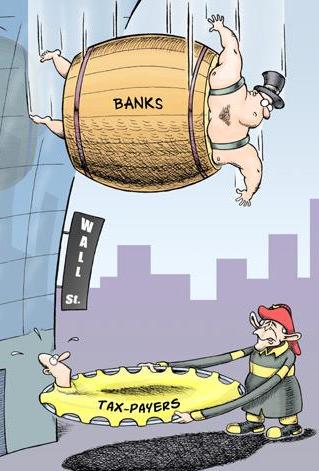Related Topics
Banking Panic 2007-2009 (1)
Mankind hasn't learned how to control sudden wealth, whether in families, third-world countries, or the richest nation in history. The world banking crisis of 2007 is the biggest example yet.
What's a Collateralized Debt Obligation (CDO)?

|
| CDO |
Securitized debt obligation (SDO) might be a better term than a collateralized debt obligation (CDO), but it never caught on, so the unwary easily confuse CDO with CDS, an entirely different derivative called a credit default swap. There will be a lot to say about credit-default swaps in the present financial muddle, but for now, we focus on the process of securitization. A CDO accomplishes the transformation of debts into securities, usually by aggregating a large number of similar debts (mortgages, construction loans, college tuition loans, etc) into an issue of bonds or stocks. In so doing, it goes from banking to finance. A bank deals with depositors, and it also deals with borrowers; its function is that of an intermediary between the people who have spare cash and other people who need to borrow it. Finance is one step removed from banking; the people who lend and those who borrow are often dealing with different institutions, who deal with each other or through an exchange. When the securitization process is complete, the lenders and the borrowers only begin the process at each end and most of the transactions end up in the hands of investors far removed from the original loan.
Although with more middle-men there are more fees to middle-men, securitization in the financial market's deals in large volumes and ordinarily introduces some important cost efficiencies. Instead of the expensive process of many bank branches painfully assembling a myriad of deposits in order to assemble enough to lend out a mortgage, much larger lumps can be assembled in Wall Street capital markets with little more than a phone call. It is possible to borrow wholesale from Wall Street, avoiding the expensive situation of sometimes having more money to lend than requests for loans, while someone else has more loans than cash to lend. Furthermore, the expensive risk of "borrowing short and lending long", that eternal nightmare of banks, is blunted. And the source of funds available for lending can become national, or international, rather than limited by the savings of local community surrounding the bank. Surpluses can be matched to loan requirements, another efficiency.
Unfortunately, the resulting creative destruction of bank branches creates one major offsetting disadvantage. The days are mostly long gone when bank managers would drive around and check whether mortgaged houses were painted and roofs kept in repair, but banks still usually have a better idea of the reputation and appearance of their customers than anyone in faraway Wall Street would ever have. Some method of risk assessment would have to be devised to replace the bank's eye on the client. It was devised, it was clever, and it was cheap. Unfortunately, its adequacy for the job is now in question as the CDO market chokes up. If it manages to survive this present test, it will surely replace the expensive old system and traditional banks will have a pretty hard time competing with it. Indeed, if things work out, the present colossal mess will be shrugged off as a good idea temporarily overwhelmed by its own success.
And if things don't work out, we certainly have a problem. The outcome revolves around figuring out some way to measure the risks and segregate them remotely by computer, thus replacing the local bank manager, whose job is to avoid the risks by looking at them one by one. Since at this point in the story we know in advance it didn't work, the flaw in the securitization of mortgages lies right here.
Originally published: Thursday, February 14, 2008; most-recently modified: Friday, June 07, 2019